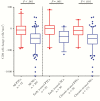The Control of HIV After Antiretroviral Medication Pause (CHAMP) Study: Posttreatment Controllers Identified From 14 Clinical Studies
- PMID: 30085241
- PMCID: PMC6217727
- DOI: 10.1093/infdis/jiy479
The Control of HIV After Antiretroviral Medication Pause (CHAMP) Study: Posttreatment Controllers Identified From 14 Clinical Studies
Abstract
Background: HIV posttreatment controllers are rare individuals who start antiretroviral therapy (ART), but maintain HIV suppression after treatment interruption. The frequency of posttreatment control and posttreatment interruption viral dynamics have not been well characterized.
Methods: Posttreatment controllers were identified from 14 studies and defined as individuals who underwent treatment interruption with viral loads ≤400 copies/mL at two-thirds or more of time points for ≥24 weeks. Viral load and CD4+ cell dynamics were compared between posttreatment controllers and noncontrollers.
Results: Of the 67 posttreatment controllers identified, 38 initiated ART during early HIV infection. Posttreatment controllers were more frequently identified in those treated during early versus chronic infection (13% vs 4%, P < .001). In posttreatment controllers with weekly viral load monitoring, 45% had a peak posttreatment interruption viral load of ≥1000 copies/mL and 33% had a peak viral load ≥10000 copies/mL. Of posttreatment controllers, 55% maintained HIV control for 2 years, with approximately 20% maintaining control for ≥5 years.
Conclusions: Posttreatment control was more commonly identified amongst early treated individuals, frequently characterized by early transient viral rebound and heterogeneous durability of HIV remission. These results may provide mechanistic insights and have implications for the design of trials aimed at achieving HIV remission.
Figures





References
-
- Goujard C, Girault I, Rouzioux C, et al. ; ANRS CO6 PRIMO Study Group. HIV-1 control after transient antiretroviral treatment initiated in primary infection: role of patient characteristics and effect of therapy. Antivir Ther 2012; 17:1001–9. - PubMed
-
- Lodi S, Meyer L, Kelleher AD, et al. . Immunovirologic control 24 months after interruption of antiretroviral therapy initiated close to HIV seroconversion. Arch Intern Med 2012; 172:1252–5. - PubMed
-
- Hocqueloux L, Prazuck T, Avettand-Fenoel V, et al. . Long-term immunovirologic control following antiretroviral therapy interruption in patients treated at the time of primary HIV-1 infection. AIDS 2010; 24:1598–601. - PubMed
Publication types
MeSH terms
Substances
Grants and funding
- UM1 AI106701/AI/NIAID NIH HHS/United States
- R21 HD094646/HD/NICHD NIH HHS/United States
- R56 AI125109/AI/NIAID NIH HHS/United States
- 385806/CIHR/Canada
- UM1 AI069496/AI/NIAID NIH HHS/United States
- P30 AI036214/AI/NIAID NIH HHS/United States
- UL1 RR024996/RR/NCRR NIH HHS/United States
- UM1 AI069419/AI/NIAID NIH HHS/United States
- U01 AI041531/AI/NIAID NIH HHS/United States
- UM1 AI069412/AI/NIAID NIH HHS/United States
- UM1 AI068634/AI/NIAID NIH HHS/United States
- P30 AI027763/AI/NIAID NIH HHS/United States
- P30 MH062512/MH/NIMH NIH HHS/United States
- P30 AI060354/AI/NIAID NIH HHS/United States
- U01 AI069419/AI/NIAID NIH HHS/United States
- U01 AI068634/AI/NIAID NIH HHS/United States
- UM1 AI068636/AI/NIAID NIH HHS/United States
LinkOut - more resources
Full Text Sources
Other Literature Sources
Medical
Research Materials

